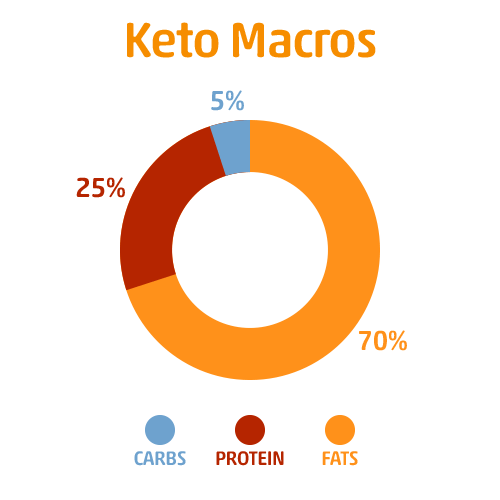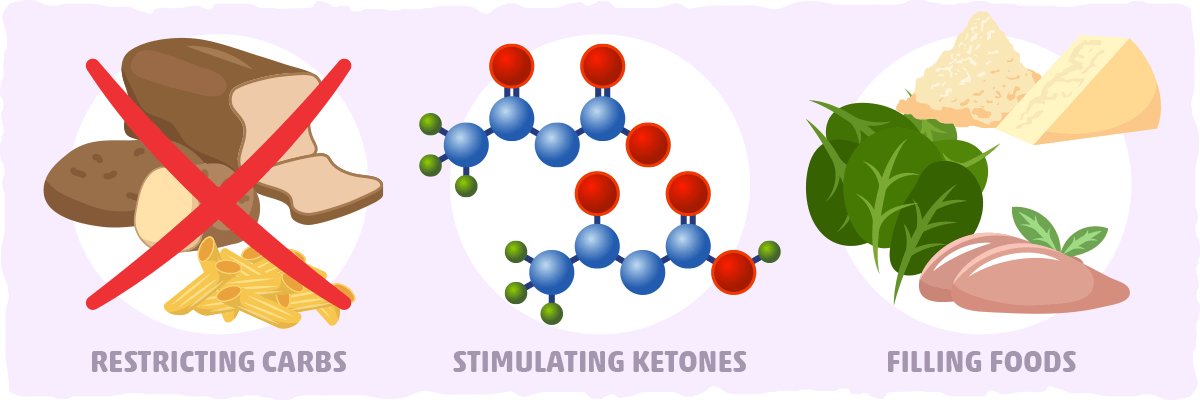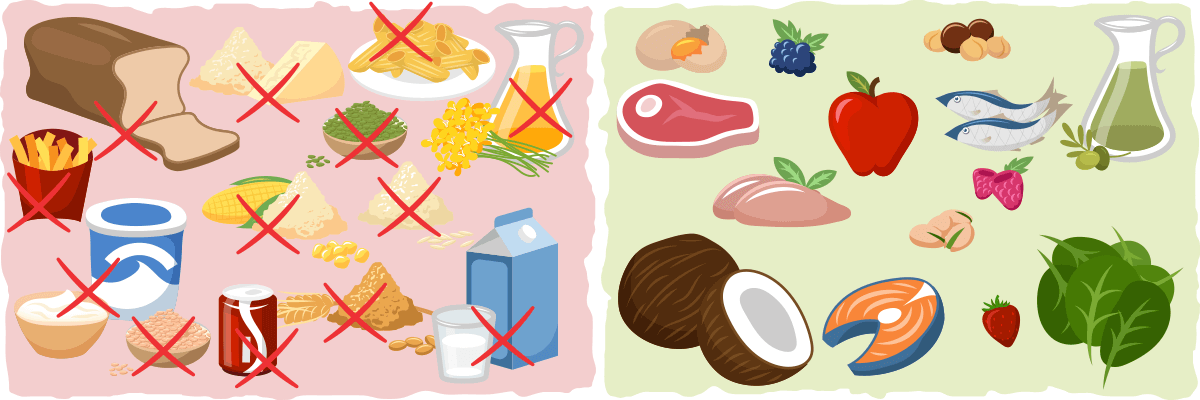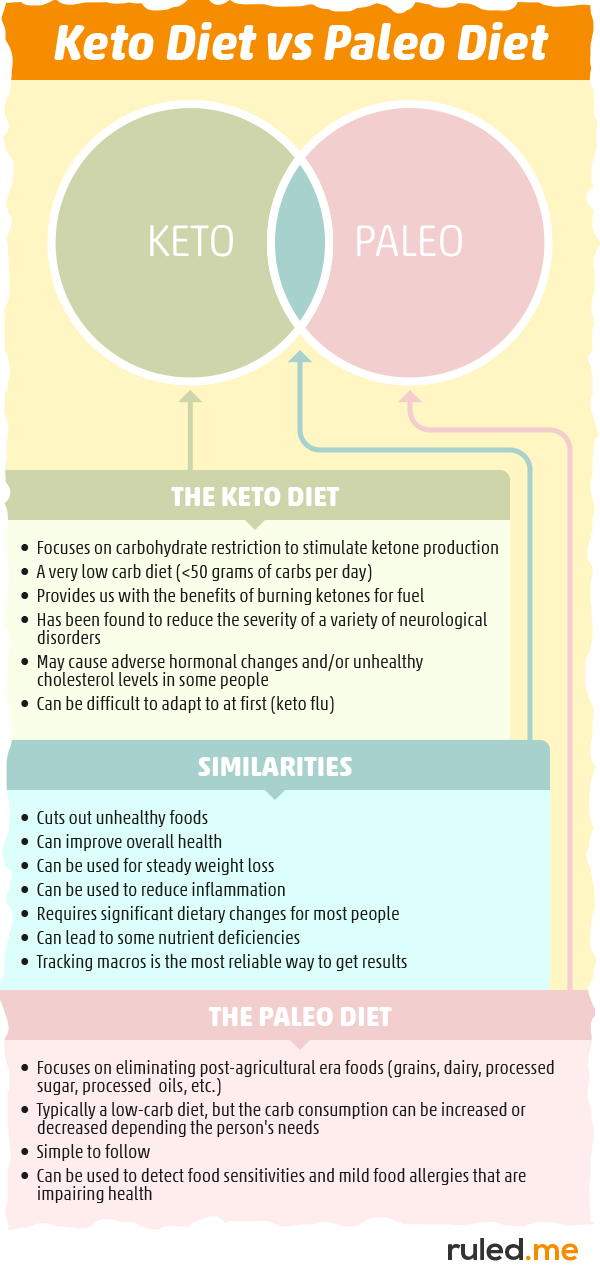If you are looking to improve your health or lose some weight, you have probably heard of the ketogenic diet and paleo diet before. Since they both restrict some of the same food groups, many people will mix them up, thinking they provide us with the same benefits.
The difference between these two diets, however, plays a more significant role than you may think. Keto dieting, for example, is designed to get you into ketosis, while the paleo diet simply eliminates specific food groups from your plate.
This one difference is all it takes to give each diet its own advantages and disadvantages. To help you figure out what dietary approach would be best for you, let’s take a closer look at both ways of eating.
The Ketogenic Diet
The keto diet was originally created to help children control and diminish the symptoms of epilepsy. The original intention behind the diet was to create a pseudo-fasting response that sends the body into nutritional ketosis without causing severe nutrient deficiencies.
Here is a simple diagram that gives you the typical macronutrient ranges of the keto diet:

As you can see, the macronutrient we restrict with keto is carbohydrates. By doing so, we take our bodies primary fuel source away and force it to adapt by burning fat and ketones for fuel.
As a result of following this way of eating, many people with epilepsy were able to reduce the severity and frequency of their seizures. On top of that, ketones (the fuel that we burn when we are in ketosis) and the keto diet were found to have many positive effects on the body, including improved mental clarity and appetite reduction.
With these promising discoveries came more research on how keto dieting and ketones can help people with common conditions, like cancer, Alzheimer’s disease, type 2 diabetes, and obesity, as well. However, the most popular benefit that carb restriction is known for is fat loss.
Keto for Fat Loss

As a fat loss tool, the ketogenic diet is undoubtedly one of the most effective nutrition programs available today. The reason why it has such a dramatic effect on the body for fat loss is that it suppresses appetite and prevents overeating in a variety of ways.
In fact, the keto diet creates a trifecta of sustainable results by:
- Restricting carbs. By cutting out the carbs, we cut out some of the most palatable foods that cause us to overeat and gain weight.
- Stimulating ketone production. When we follow the keto diet, we end up burning more ketones in place of sugar. Ketones have been found to suppress appetite.
- Prioritizing filling foods. Protein and fiber are the two most satiating nutrients we can have and many of the food that people eat on keto will have one, the other, or both in them. On top of that, many people find fatty food to highly fulfilling as well.
Altogether these three factors cause keto dieters to feel fuller longer and eat fewer calories. This the primary reason why keto provides sustained weight loss for many people.
However, let’s not forget about the Paleo diet. Although it isn’t the same as the keto diet, it still has the potential to improve health and body composition dramatically.
The Paleo Diet

With the help of Dr. Loren Cordain, the Paleo diet became popularized as the diet that we were evolved to eat. What exactly does this mean?
There is quite a lot of debate on this topic, which has lead to many different iterations of the Paleo diet. However, what most Paleo dieters agree on is that we should cut out (or at least limit) foods that came from the agricultural era (dairy products, grains, sugar, legumes, processed oils, etc.).
In general, Paleo eating primarily consists of high-quality meat, fish, vegetables, and fruits while limiting dairy, grain, legume, and processed oil intake. The primary focus of the Paleo diet is on food quality (not quantity), cutting out the “unhealthy” and replacing it with the “healthy.”
One of the biggest advantages of this approach is that it offers a wealth of health benefits without forcing you to revolve your lifestyle around incredibly strict nutrient ratios. Simply by substituting paleo-approved foods for the foods that came after we started cultivating grain and domesticating animals, you will theoretically be able to eat like our ancestors and improve your health.
You can also use this dietary approach as a pseudo-elimination diet that allows you to find out if you are allergic or sensitive to common foods (e.g., wheat and dairy) — or you can fall back on Paleo eating if the keto diet isn’t the right diet for you.
Making the Right Choice: Should You Follow Paleo or Keto?
The choice between the Paleo diet and ketogenic diet should not be taken lightly. Both diet plans will require serious commitment — after all, they require removing some of the most palatable and accessible foods. But in their own ways, both diets are going to help you lose weight and optimize your health.
To make it easier for you to decide, let’s take a look at the deal-breakers for each diet.
When Keto Isn’t Right For You
Although the keto diet can help with a plethora of conditions, it is not the best diet for everyone.
People with thyroid issues or familial hypercholesterolemia, for example, may struggle to stay healthy while restricting carbs.
Just because one person yielded incredible results by using keto doesn’t mean it is the best option for you too. If you decide to try the diet for yourself, make sure you are mindful of your health and how you feel with this way of eating.
After one to two months of keto dieting, you will be able to figure out if keto is right for you. If your health declines after the keto flu symptoms pass, then you may fare better with a diet, such as the Paleo diet, that is higher in carbs than keto.
When Paleo Isn’t Right For You
Paleo is almost as difficult to follow as keto. Eliminating all grains, dairy, legumes, processed oil, and sugars for your diet is difficult — especially when you consider the fact that they are the top sources of calories in westernized society.
On top of this, you may end up missing out on some vitamin and minerals that many of us get from the foods that paleo claims are not healthy. This can lead to specific nutrient deficiencies that set the stage for future health issues.
Another downside of Paleo is that you will not experience the benefits of ketosis. The keto diet is the only diet that allows you to sustain ketosis without having to fast.
The Advantages and Disadvantages of Paleo and Keto
Here is a quick overview of the advantages and disadvantages of each diet:
Advantages of the Ketogenic Diet
- Cuts out many unhealthy food items
- Reduces calorie intake without increasing hunger
- Promotes sustained ketosis in a healthy way
- Provides us with the benefits of burning ketones for fuel
- Effective at fostering steady weight loss
- Can be used to help people who have diabetes, cancer, cognitive impairment, and epilepsy, as well as many other conditions
- Helps decrease chronic inflammation
Disadvantages of the Ketogenic Diet
- Must be very strict with carb intake to follow properly
- Requires you to track your macros for best results
- Cuts out many of the most enjoyable foods
- May cause adverse hormonal changes and/or unhealthy cholesterol levels in some people
- Difficult to adapt to for many people (see our article on the keto flu to learn why)
- Impairs many aspects of high-intensity exercise performance
- Leaves you vulnerable to some vitamin and mineral deficiencies
Advantages of the Paleo Diet
- Follows simple rules
- Replaces processed foods with healthier foods that are more satiating
- Makes it easier to maintain a calorie deficit and lose weight without having to track calories
- Can improve overall metabolic health and help reduce the severity of many common conditions like heart disease and type 2 diabetes.
- Provides us with enough carbs to maintain high-intensity exercise performance
- Helps decrease chronic inflammation
- Allows us to decrease carb intake without provoking keto flu symptoms or adverse hormonal changes
Disadvantages of the Paleo Diet
- Can be challenging to implement
- Cuts out many enjoyable foods
- May lead to a deficiency in some vitamins and minerals
- May require you to track macros for best results
Here is Venn diagram to make it easier to see the differences and similarities between the two diets:

Whether you choose Paleo or keto depends on your goals, your health, your lifestyle, and your food environment. If you want to reap the benefits of ketosis, for example, then keto is the way to go.
In contrast, for those of you who would rather just cut out specific food groups without rigidly restricting carbs, then Paleo will be great for you.
In general, if your current diet choice doesn’t help you meet your goals while also improving your health, then it’s best to either try the other diet (or you can try tracking your macros more precisely to see if that helps).
It is also important to keep in mind that Paleo and keto are not the only diets that you can use to help you lose weight and optimize your health.
As long as your diet follows these two principles, then you are on the right track:
- It consists of highly-satiating and healthy foods (i.e., protein-dense, micronutrient-rich, and/or high-fiber foods).
- It limits the consumption of all calorically-dense processed foods that aren’t making your healthier.
Putting It All Together — The Paleo Ketogenic Diet
Truthfully, you don’t have to choose one diet over the other. It is possible to follow a ketogenic diet while also adopting some of the primary principles of the Paleo diet so that you can get the benefits of ketosis and Paleo eating.
You can do this by following the keto macronutrient ratios (carbs, fats, and protein) while also removing all foods that are not Paleo-approved. When it comes to food choices, keto and Paleo are so similar that you only have to make one shift to get the benefits of both: take out the dairy.
If you want to reap the benefits of ketones and limit dairy consumption for any reason, then you may find a Paleo keto diet to be the best option for you. To learn how you can implement this unique way of eating, check out our comprehensive guide to dairy-free keto.
The Key Takeaway — What is The Best Diet For You?
Whether you decide to follow the Paleo diet, the keto diet, a Paleo keto diet, or any other way of eating, you must keep these two diet truths in mind:
- No diet is best for everyone. Just because they got results with one dietary approach doesn’t mean it is the best diet for you. You may have to go through some experimentation before you figure out a diet plan that helps you achieve all of your goals.
- The key to weight loss is being in a calorie deficit. It is hard to make a conclusive statement about anything regarding nutrition, but we can say one thing for sure based on the current literature: calories are the most important variable when it comes to weight loss. To lose weight, you must follow a diet that allows you to sustain a calorie deficit. Whether it is low carb, low fat, vegan, or a 100% all meat diet, being in a caloric deficit is the key to weight loss.
In general, your diet should help you:
- achieve a healthy body composition.
- optimize your health
- enjoy life to the fullest.
And, most importantly, your diet should help you sustain all three for the long-term.
For many of you, the diet that does this will be the ketogenic diet (or some variation of it). If you’d like to learn more about how you can get started with the keto diet, feel free to check out our beginner’s guide and browse through the dozens of articles and guides on our website.
Sources:
- How to Lose Weight on a Ketogenic Diet — Ruled.me
- Ketones And The Brain: The Unique Benefits of Keto — Ruled.me
- The Benefits of The Ketogenic Diet — Ruled.me
- The Modern Take on the Paleo Diet: Is it Grounded in Science? — University Health News
- Paleolithic nutrition for metabolic syndrome: systematic review and meta-analysis — NCBI
- Prevalence of micronutrient deficiency in popular diet plans — NCBI